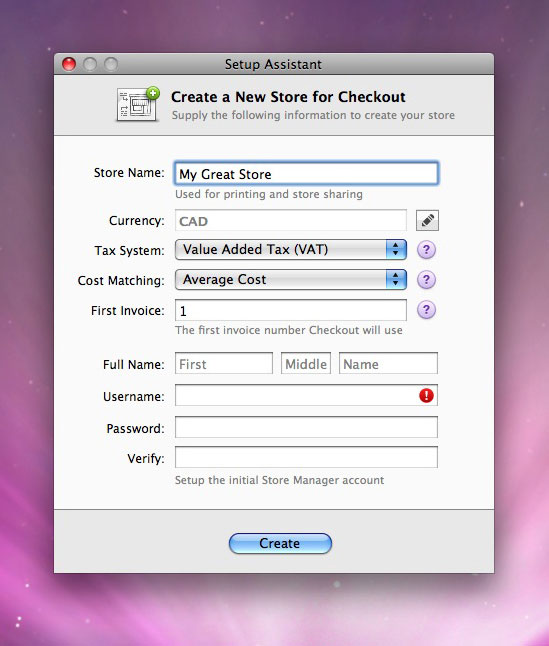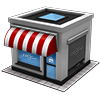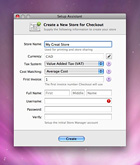5. Set Up Your Store
5.1 What is a Store?
A Checkout store represents one physical store which includes all customers, products, suppliers and more that are used on a day-to-day basis. Checkout has a built-in server, and each Mac running Checkout can host one or more stores. This server can share stores over a network with other Macs. These machines will automatically seek out shared stores on the local area network, and providing you have a valid username and password to access those stores, you will be able to log into them from your Mac and vice-versa. After the 30 day trial period has ended, all Macs must be registered to network a store.
5.2 Converting Your Checkout 3.x Store
If you have a store that you used in Checkout version 3.0.5 or later, you must first import that store into the Checkout 4.x database. Stores that are still using Checkout 3.0.4 or earlier will need to upgrade the database to Checkout 3.6 before it be imported into Checkout 4.x, more information on this process can be found in our FAQ. To import the store, first make a backup with the 3.x software by going to the Checkout menu and Manage Checkout Stores. Once the store has been backed up, Checkout 3.x can be closed and Checkout 4.x can be opened. Upon the Welcome Window of Checkout 4.x, you will receive a message to import all stores found inside of the Checkout 3.x database, this message will only appear if no stores are found inside of the Checkout 4.x database. If you prefer to not import all stores, the recommended way is to restore the backup file made earlier to your Checkout 4.x program. To do so, select the Checkout menu, then Manage Checkout Stores. Once the store is imported to Checkout 4.x, you can login to the store which will prompt for an upgrade. Be aware this process has to be done on each store you wish to upgrade and can take awhile depending on the size of the store file.
5.2.1 Converting Your Checkout 2.x Store
If you have a store that you used in Checkout version 2.x, you must first convert that store to be used in Checkout 3.0. To do so, first create a backup of your 2.x store by selecting Manage Stores on the Welcome Window. Once you have created a backup, launch Checkout 3.0 and log into your store. Checkout will them ask you if you wish to convert your Checkout 2.x store to the Checkout 3.0 store format. Confirm that you wish to do so by clicking the Convert button. This process can take awhile, depending on the size of the store file. If you have multiple stores, you will have to upgrade each one the first time you log into it. After you have upgraded to Checkout 3.x, you can now download Checkout 4.0 and follow the instructions in 5.2 to upgrade your Store.
5.2.2 Converting Your Old Checkout 1.x Store
If you have a store that you used in Checkout version 1.x, you must first convert that store to be used in Checkout 2.0. To do so, first create a backup of your 1.x store by going to the File menu and choosing Reveal Database. Copy the file named Store.Checkout to a new location, being careful not to move it. Once you have created a backup, launch Checkout 2.x. The program will find your 1.x store automatically, and then will ask you if you wish to convert your Checkout 1 store to the Checkout 2 store format. If you need the link to Checkout 2.x, contact Checkout Customer Service. Confirm that you wish to do so by clicking the Convert button. This process can take awhile, depending on the size of the store file and can sometimes fail. If it does fail, your data is fine. You can attempt the conversion again, and if the conversion continues to fail, contact Checkout Technical Support. After you have upgraded to Checkout 2.x, you can now download Checkout 3.0 and follow the instructions in 5.2.1 to upgrade your Store.
5.3 Creating a New Store
If you are not converting your store from a prior version of Checkout, you will need to create a new store to work in.
1. The first step in creating a new store is to click ‘Create new Store’ from the Welcome Screen. You will be prompted to authenticate by entering your Mac password. Once you have entered your Mac password, you will be brought to the Setup Assistant screen.

3. Next, you must decide what type of currency you intend to use. Be careful to select the proper currency, as once you have selected a currency to use, you cannot go back and change it. If you do need to change the currency that Checkout will use, select the pencil next to Currency to have Checkout automatically open your Mac's System Preferences.
4. Now, you are going to need to choose a tax system. There are two options to choose from. Sales Tax is a tax based on the cost of an item or items purchased and is collected directly from the buyer, and paid to the government by the retailer. Value Added Tax (VAT) is a tax that is based on each exchange of the item or items and is collected upon each exchange, meaning that tax is collected from the manufacturer, retailer and consumer and then paid to the government by the raw material provider, manufacturer and retailer. To simplify, a sales tax is used by U.S. and Canadian Province governments while a Value Added Tax is used in most other countries.
5. Next up is to choose a cost matching method. Again, the program offers two options. First In, First Out (FIFO) is an option that is used by many companies such as roofing retailers. A product is purchased by the retailer at a specific amount, and more of the same product is later purchased at a higher or lower amount. When cost matching, the system will use the cost of the oldest existing inventory in stock to determine the margin on the sale. The Average Cost method will take all of the purchases of that item, average out what the cost of those items were, and then determine the margin on the sale based on the average cost of the product. Be sure to select carefully, as this is not something you can go back and change at a later time.
6. Setting the First Invoice number is important since Invoice numbers can not be modified, and will continue consecutively as you use Checkout. This is especially important if you are moving from another application, and wish to continue your current numbering sequence.
7. Now, it’s time to select a login and create a password for that login. This first login will have a Manager's role and will access to all functions of Checkout. When choosing a password, try to make it as safe as possible. This will prevent other users from being able to log in to your store. Typically, a combination of alpha-numeric characters works best. The password can be as short as 1 character in length. Once you’ve chosen a safe password and verified it, click on the Create button. You will see a status message and then you will be brought to the login screen. Here, enter your login and password and click the Login button to proceed.
5.4 Initial Settings
Each store can be uniquely customized to benefit your company.
5.4.1 Setup Employees
As the manager of the store, you are likely going to have employees who will need access to the program, but you may not want to give them access to the manager screen. To create a new login for an employee, click on the Manager button on your top menu. Once there, click on the Employees button. For more detailed information on employees, please see Chapter 8: Managing Your Employees.
5.4.2 Setup Taxes
Depending on the tax system you chose in your initial setup, you will now need to setup your taxes. To get there, click on the Manager button on your top menu. Once there, click on the Taxes button. You can create multiple taxes and select if they'll default onto new Products. For more detailed information on taxes, please see Chapter 9: Managing Your Taxes.
5.4.3 Setup Suppliers
If you will be taking advantage of the Stock Room to create, print, and receive Purchase Orders, you will first need to create Suppliers. To get there, click on the Manager button on your top menu. Once there, click on the Suppliers button. For more detailed information on Suppliers, please see Chapter 10: Managing Your Suppliers.
5.4.4 Setup Shipping
If you offer shipping, and want to create shipping methods that optionally can have a default price, you will first need to create Shipping methods. To get there, click on the Manager button on your top menu. Once there, click on the Shipping button. For more detailed information on Shipping, please see Chapter 12: Managing Your Shipping.
5.4.5 Create or Import Customers
While Checkout does not require Customers to be assigned to Invoices, to save Orders or Quotes, you are going to need to have customers to add to them. You can create your customers one at a time and also import them from a vCard, comma separated or tab delimited file. For more details on customers, please see Chapter 21: Managing Customers.
5.4.6 Create or Import Products
So, now that you’ve got a customer list created, you’re going to need products to sell. To create a new product, you have to go the Manager button on your top menu. Once there, click on the Products button. Click on New Product and the New Product window will appear. You can also import your products from a tab delimited or comma separated file. For more details on products, please see Chapter 11: Managing Products.
5.4.7 Customize Your Template
To customize your template, go to the Manager button on your top menu and then choose the Template button. This will bring you to a page with 7 template themes. Choose the theme you wish to edit by clicking on it at the bottom of the screen. From there, you are given the options to edit the Logo and Store Information, Document Numbering, Print Margins and Advanced Options. To edit any of those, click on the Edit button to the right of the option you wish to change. For more detailed information on template customization, please see Chapter 13 Managing Your Templates.
5.4.8 Linking to your Web Store
Checkout can link to Shopify, a full-featured ecommerce platform, and upload your products and their images, and download all new web orders. For more detailed information on Web Store integration, please Chapter 14 Managing Your Web Store.
5.5 What’s Next?
Now that you’ve created your store and have customers and products all set up, you need to know where to go from here. We suggest starting with Chapter 19: Managing Orders.
Table of Contents
- Welcome to Checkout
- About this Manual
- The Welcome Screen
- Registering Checkout
- Set Up Your Store
- Managing Your Store
- Managing Your Store - General
- Managing Your Employees
- Managing Your Taxes
- Managing Your Suppliers
- Managing Your Products
- Managing Your Shipping
- Managing Your Templates
- Managing Your Shopify Web Store
- Managing Your Reports
- Managing Your Ledger
- Logging In
- Daily Usage - General
- Daily Usage - Managing Orders
- Daily Usage - Managing Invoices
- Daily Usage - Managing Customers
- Daily Usage - Till Count
- Daily Usage - Printing Labels
- Stock Room

